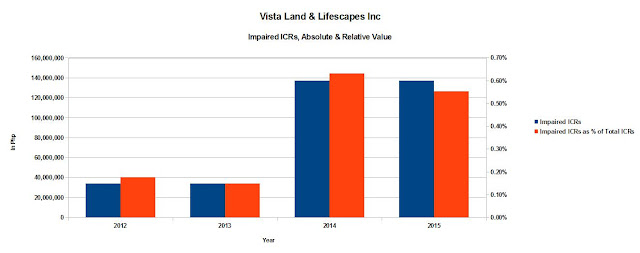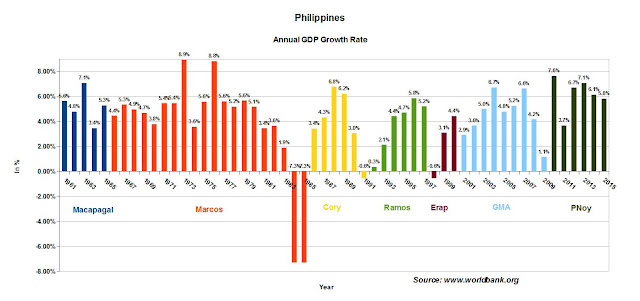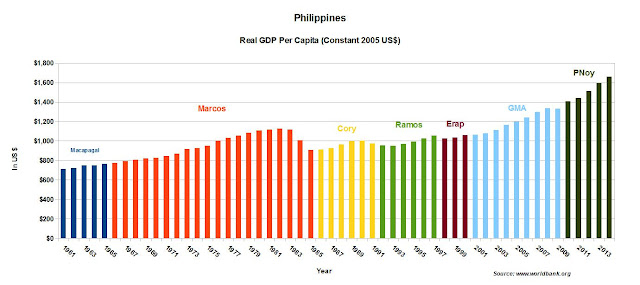In March 2015, two illustrious economists, both Former Fed Chairman Ben Bernanke and Former Treasury Secretary Larry Summers have been duking it out on the blogosphere about secular stagnation. In layman's terms, both are attempting to describe why does the US Recovery from the Great Recession feel so sluggish.
Although the overall collapse in REAL GDP was relatively shallow (-3.1% from peak to trough in real terms and -0.4% in nominal terms) and took place over two years (2008 to 2009), the recovery in the five years since then has been very anemic. The economy reached parity with its pre-recession peak GDP in nominal terms in 2010, only three years after the Great Recession started in December 2007. In real terms, it took an additional year, by 2011, to reach parity with its pre-recession peak. By the 1st Qtr of 2016, the US economy is only 26.37% larger, in nominal terms, than the bottom in 2009, averaging only 3.40% growth every year since the Great Recession bottomed out. In real terms, the US economy is only 16.52% larger than the bottom in 2009, averaging only 2.21% growth every year since 2009.
The overall economic contraction during the Great Depression was much more severe (-46% in nominal terms and -27% in real terms from peak to trough) and took much longer (four years from 1930 to 1933). In real terms, economic parity with its pre-depression peak was only reached in 1936, seven years after the start of the Great Depression. Despite the severity and depth of the economic contraction, it only took three years after the 1933 bottom for the US economy to reach parity (in real terms) with pre-depression peak in 1929. Recovery, in terms of economic growth rates, was a lot more robust, averaging 10.9% annually during this period. In the four years since the US economy bottomed out in 1933, the US economy was 43.5% larger than the bottom in 1933, averaging 9.44% growth per year every year. In nominal terms, the US economy only recovered its pre-depression peak only sometime in 1941, when WWII spending began in earnest.
Great Depression vs. Great Recession
Source: www.worldbank.org, www.bea.gov, Reinhart and Rogoff, "This Time is Different"
Search This Blog
Friday, April 29, 2016
Friday, April 22, 2016
The Philippine Real Estate Bubble Has Also Burst for Vista Land
Last year, we documented how the Philippine Real Estate Bubble had already burst for HOUSE (8990 Holdings, Inc.) wherein there was a marked deterioration in 2014 in delinquencies in the company's installment contract receivables (ICRs) for the year 2014.
A simple chart tells the story:

Simply put, 8990's ICRs that were over ninety days past due jumped by a minimum factor of 10 times in the year 2014. Around 10% of HOUSE's ICRs became impaired.

In a subsequent post on a related blog, we noted that a similar dynamic was playing out in Vista Land & Lifescapes, Inc. (VLL), one of HOUSE's main rivals in the mass housing market space. Although not quite as acute as HOUSE, VLL exhibited a significant deterioration in the credit quality of its ICRs.


The deterioration has continued throughout the whole of 2015, confirming that real estate bubble has also burst for VLL. In 2015, there was a marked jump in VLL's ICRs that were over 90 days past due.
Unlike HOUSE, the value of the impairments relative to the entire ICR portfolio is very small - less than 1% for VLL versus 10% for HOUSE.
Source: Vista Land & Lifescapes, Inc.
A simple chart tells the story:

Simply put, 8990's ICRs that were over ninety days past due jumped by a minimum factor of 10 times in the year 2014. Around 10% of HOUSE's ICRs became impaired.

In a subsequent post on a related blog, we noted that a similar dynamic was playing out in Vista Land & Lifescapes, Inc. (VLL), one of HOUSE's main rivals in the mass housing market space. Although not quite as acute as HOUSE, VLL exhibited a significant deterioration in the credit quality of its ICRs.


The deterioration has continued throughout the whole of 2015, confirming that real estate bubble has also burst for VLL. In 2015, there was a marked jump in VLL's ICRs that were over 90 days past due.
Unlike HOUSE, the value of the impairments relative to the entire ICR portfolio is very small - less than 1% for VLL versus 10% for HOUSE.
Source: Vista Land & Lifescapes, Inc.
Friday, April 15, 2016
Great Depression vs. Great Recession: Unemployment - Updated March 2016
The reported unemployment rate during the Great Depression was significantly higher than the reported unemployment rates of the Great Recession.
But are the two rates comparable? Before 1938, children were a significant part of the labor force. In 1900, children younger than sixteen made up as much as eighteen percent of the labor force. It was only when the Fair Labor Standards Act of 1938 became law that children younger than sixteen were barred from working in manufacturing and mining but not agriculture.
To make the numbers more comparable, it is better to get the ratio of Employment to the Total Population (which includes children). When we do this, the two measures are not so far apart. In 1929, the year "0" for the Great Depression, 54.41% of the total population was employed. By 1933, year "4", only 41.97% of the population was employed. But the rise in employment was dramatic. Four years later, 47.63% of the population was employed, almost six percentage points higher. The employment momentum only stalled when the tax hikes of 1937 induced another recession in 1938 and new child labor laws barred children from the labor force. If the momentum had continued, the employment ratio would have recovered in less than five years.
In 2007, the year "0" of the Great Recession, 48.38% of the population was employed. Four years later, only 44.82% of the population was employed, a drop of less than 4 percentage points. By March 2016 or four years after the Great Recession bottomed out, only 46.70% of the population is employed, an increase of only 2.01% percentage points. The growth rate of employment was less than a third that of the Great Depression. At this rate, it will take four more years or 2020 before employment recovers to that of Year "0".
Great Depression vs. Great Recession
Sources: www.worldbank.org, www.bea.gov, www.bls.gov, Reinhart and Rogoff, "This Time is Different"
But are the two rates comparable? Before 1938, children were a significant part of the labor force. In 1900, children younger than sixteen made up as much as eighteen percent of the labor force. It was only when the Fair Labor Standards Act of 1938 became law that children younger than sixteen were barred from working in manufacturing and mining but not agriculture.
To make the numbers more comparable, it is better to get the ratio of Employment to the Total Population (which includes children). When we do this, the two measures are not so far apart. In 1929, the year "0" for the Great Depression, 54.41% of the total population was employed. By 1933, year "4", only 41.97% of the population was employed. But the rise in employment was dramatic. Four years later, 47.63% of the population was employed, almost six percentage points higher. The employment momentum only stalled when the tax hikes of 1937 induced another recession in 1938 and new child labor laws barred children from the labor force. If the momentum had continued, the employment ratio would have recovered in less than five years.
In 2007, the year "0" of the Great Recession, 48.38% of the population was employed. Four years later, only 44.82% of the population was employed, a drop of less than 4 percentage points. By March 2016 or four years after the Great Recession bottomed out, only 46.70% of the population is employed, an increase of only 2.01% percentage points. The growth rate of employment was less than a third that of the Great Depression. At this rate, it will take four more years or 2020 before employment recovers to that of Year "0".
Great Depression vs. Great Recession
Sources: www.worldbank.org, www.bea.gov, www.bls.gov, Reinhart and Rogoff, "This Time is Different"
Monday, April 11, 2016
The Mysterious Decline of Filipino Students in the US
There is a noticeable decline in the number of Filipino students in US Colleges and Universities, based on data from the Open Doors Report. The number of Filipino students in US tertiary education peaked at 4,225 students in 2008 and is now at 3,026 students as of 2014-2015 school year. This number is even lower than that of the year 2000, when 3,139 Filipino students were participating in US higher education.
Source: Open Doors Report, 2015
It is not clear why this is happening. This decline has come at a time when the country has experienced very solid economic growth that is one of the best in Asia, under the leadership of both Presidents Gloria Macapagal-Arroyo and Benigno Aquino III
The decline has also come about at a time when almost every ASEAN neighbor, with the exception of Thailand (which has been mired in political uncertainty), has been increasing the number of students it sends the US universities.
In absolute numbers, the Philippines ranks below Singapore, which has a population that is around 1/20th the size of the Philippines but above low-income or low population countries such as Brunei, Cambodia, Laos, and Myanmar. Vietnam, which is almost as big as the Philippines in terms of population, sends more than six times as many students to the US.
In terms of percentage of tertiary students, the Philippines ranks second to the last in the ASEAN, above low-income Laos. At 0.15% of its tertiary education student population, even the former hermit country Myanmar, ranks higher than the Philippines (which had 0.11% as of 2012). Naturally, rich Singapore sends roughly 5% of its tertiary education students to study in the US higher education system.
Source: www.worldbank.org, 2015 Open Doors Report
Are Filipino Universities getting better? It is not clear that they are getting better. From this infographic from CNN Philippines, the ranking of the top four universities in the Philippines have declined in recent years.
Could the decline be due to the increasing unaffordability of a college education in the US? Since 1995, out-of state tuition and fees have climbed a staggering 226 percent for public universities.
Based on data from the College Board, the annual undergraduate student budget now averages US $38,541 for a public four-year out-of-state on campus education as 2015. For a private nonprofit four-year on campus education, it's even worse: US $47,831.
As a result, college has become unaffordable for many, including American workers. These figures represent 126% and 160% of US worker median compensation of $30K as of 2014. Most US students pay an average net price that is substantially lower than published college prices, as much as 28% lower. The discount is primarily due to financial aid and grants available to US students.
Most of the time, foreign students don't qualify for financial aid and, in fact, subsidize low-income American students by paying full freight for their education. This education can cost around US $160K to $200K for a four-year college education.
So, by definition, foreign students come from relatively well-off families in their home countries in order to study abroad. According to the 2015 Credit Suisse Global Wealth Report, around 530K Filipino adults had wealth greater than US $100K. Of this, around 471K Filipino adults had wealth between US $100K to US $1M, and around 59K Filipino adults had wealth greater than US $1M.
So as of 2015, Filipino students in the USA amounted to 0.55% of wealthy adults in the Philippines. This ratio is similar to that of Indonesia and Laos, both at 0.55%. The outlier here is Vietnam, where the Vietnamese foreign student population in the USA amounts to a staggering 29.42% of the wealthy adult population in Vietnam.
Given all this information, it is still not clear why the absolute number of Filipino students in US Colleges and Universities is declining. This phenomenon remains a mystery.
Monday, April 4, 2016
Was the Economy Better Under Marcos?
Five years ago, Bong Bong Marcos said that "If there was no EDSA 1, if my father was allowed to pursue his plans, I believe that we would be like Singapore now.”
During the Martial Law years, the Philippines posted the highest annual GDP growth rates at 8.9% in 1973 and 8.8% in 1976. No other President has come close to this record, save for the 7.6% annual GDP growth rate posted in 2010 under PNoy. Unfortunately, the Marcos regime also posted the most negative GDP growth rates the country has ever seen, a negative 7.3% in both 1984 and in 1985, the last two full years that his father was in power.
Without this, the Marcos regime would have averaged a whopping 5.11% annual average per year. With these negative years, the Marcos regime averaged a respectable 3.83% - slightly lower than Cory's 3.86% and still above the 3.76% average annual growth posted under Ramos or 2.31% under Erap.
By itself, GDP growth is not the real deal. GDP growth can be offset by population growth. What matters is Real GDP growth per capita - the inflation-adjusted growth in economic income of every man, woman, and child in the country. If Real GDP per capita barely grows, then, in reality, the economic growth for most people is almost imperceptible.
Marcos began his administration with a Real GDP per Capita of $763 in 1965 and ended it more than 20 years later with a Real GDP per capita of $907, resulting in a compounded annual growth rate of only 0.87% per year. This is even lower than the much maligned "Hindu Rate of Growth" of one percent per annum - a growth rate so slow that it becomes imperceptible to the general population. This rate of growth ranks the second lowest among our last seven presidents. Only Erap, whose presidency took place during the Asian Financial Crisis, posted lower growth rates - a measly 0.10% per year.
Our real economic growth was so slow that at least three other low-income nations overtook us in terms of real economic development during the 22 plus years of the Marcos regime, including our ASEAN neighbor Thailand. In non-inflation adjusted terms, at least seven other developing countries overtook us.
Pinoy Rate of Growth
A Stealing Analysis of the Marcos Regime
Putin vs. Marcos: Who is the Bigger Kleptocrat?
On the Collective Amnesia of the Philippine Electorate Regarding the Marcos Dictatorship
Just How Rich Are The Marcoses Today?
The Divergence: A Tale of Two Countries
Friday, April 1, 2016
Is Another US Recession Underway?
Is another recession in the US underway? Total US Business Sales, which includes monthly sales by all US businesses - not just large cap S&P 500 companies, has slumped 4.62% from its high of $1.365 trillion last July 2014 to just $1.302 trillion as of December 2015.
As the chart below indicates, significant drops in Total US Business Sales have coincided with the past two US recessions.
In the 2000 recession, Total US Business Sales dropped almost 5% from its peak of $845.362 billion in September 2000 to $803.422 billion just one year lates.
In the Great Recession, Total US Business Sales peaked at $1.221 trillion in June 2008. It then dropped by a staggering 22.02% to reach $952.160 billion by April 2009.
Subscribe to:
Posts (Atom)
























